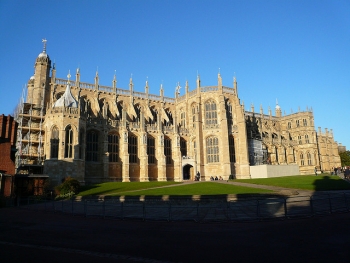The Romance of St Georges Chapel-Windsor Castle

In 1471 the civil war between Lancastrians and Yorkists came to an end. King Edward IV had prevailed decisively over his enemies and the future of the new Yorkist dynasty seemed assured. Within a short time the king decided to build a new and more splendid St George`s chapel within Windsor Castle. This was to serve as his own tomb and chantry. It would also commemorate by the splendour and richness of its design the triumphs of the new royal dynasty. On 19th February 1473 Edward therefore instructed Richard Beauchamp, Bishop of Salisbury, to choose bricklayers, plumbers, carpenters and masons to work at Windsor.
The ground to the west of the old St George`s Chapel was cleared and then, in June 1475, the construction of a new Chapel was begun under the supervision of Beauchamp, who at the same time was made Chancellor of the Order of the Garter, and, three years later, Dean of Windsor. Taynton stone was brought by river from the Costwold town of Burford, timber from the neighbouring villages of Upton, Farnham, and Sunninghill; and with Thomas Canceller as clerk of the works, William Berkley head carver, Henry Jenyngs head mason, and John Tresilian head smith, building began. The choir and its aisles were the first parts of the chapel to be carried up to their full height and roofed in; in addition a portion of the choir aisles was vaulted in stone. The canopied stalls in the choir were erected by 1485, and the nave walls as far as the two western chapels reached the height of the window sills by or before 1503. We can picture the men at work in the chapel, each party of workmen under the supervision of a master craftsman. John Tresilian, a Cornishman, with the help of his smiths, made the iron gates which are reckoned the finest piece of iron-work in the country surviving from the middle ages. These gates were designed to protect the chest-tomb and effigy of King Edward IV. The raised part of the tomb and the effigy have since been replaced by a large wall-structure filling in the arch, but Tresilian`s gates remain, and still serve as a direct memorial to Edward IV. Tresilian`s attention was next directed to the locks on the doors of the chapel, which he made with such skill that today they are as good as when they were first fixed in the doors. While the smiths were at work, masons and wood-carvers were engaged at their special tasks. During the short reign of King Richard III, from 1483 to 1485, work on the chapel may have been continued, although no record of what was completed is in existence. It seems likely that little major work was done for almost 20 years until, in 1503, a generous bequest by King VII`s minister, Sir Reginald Bray, K.G., enabled the chapel to be completed.
Between 1503 and 1509, under the supervision of Sir Reginald`s executors, the nave was carried further westward so as to include two more side chapels at the west end, and when the work on the walls was complete the nave and transepts were roofed in as they are today. Bosses of great interest and beauty were carved on the magnificently vaulted roof. There can be seen, among many others, the Tudor portcullis, white and red roses interspersed, a boss in the centre representing the hawthorn tree of Bosworth Field, the arms of Dean Urswick and of John Oxenbridge, and the arms and badge of Sir Reginald Bray.
The task was finished in 1509, by which time the choir, which had before only a wooden roof, had also received its splendid stone vault. The choir vault was the subject of a building contract the terms of which survive. It was between King Henry VII and the Knights of the Garter, on the one part, and the two freemasons, John Hylmer and William Vertue, on the other part. The contract, dated 5th June, 1506, stipulates that the whole choir was to be vaulted by Christmas Day, 1508, and that 700 pounds was to be paid for the work. The participation of the Knights in the work was symbolized by the appearance of their arms on twenty of the choir bosses. Probably at about the same time the original set of King`s Beasts was placed on the pinnacles.
From the one engraving in existence by Hollar, published in 1672, it is impossible to give any description of these beasts; but we may conclude that, in accordance with the Tudor custom, the houses of York and Lancaster were represented in those strange animals with their heraldic shields. In this way, both inside and outside, there was striking evidence that the Wars of the Roses had been brought to an end and both factions united under the rule of a Tudor king. The roof of the ambulatory behind the altar was paneled in stone by 1509, and so, thirty-four years from the beginning of the work, the chapel was completed, except for the stone vaulting over the crossing; this was added in 1528 by King Henry VIII, whose arms can be seen in the centre of the vaulting surrounded by the arms of the Knights of the Garter of that time.
This majestic despot had already displayed interest in the chapel which was later to result in his choce oof it as his burial place,for at the beginning of his reign he had converted the chapel over King Edward IV`s tomb into a royal pew, where Queen Catherine of Aragon could sit with her ladies and watch the ceremony of the installation of the Knights of the Garter. On the centre panels of its exquisitely-carved wooden balcony are the badges of King Henry VIII and Queen Catherine. St George`s Chapel was completed only just in time; there followed almost immediately half a century of religious strife. Throughout that period, however and throughout the succeeding centuries, the Deans and Canons of Windsor have striven to preserve the unique fabric entrusted to their care, calling to their aid men of such outstanding ability as Sir Christopher Wren in the seventeenth century, Henry Emlyn in the eighteenth, Sir Gilbert Scott in the nineteenth, and Sir Harold Brakspear in the twentieth.
Let us now stand inside the chapel; and as the eye follows those tall, graceful shafts to the vaulted roof, we see there the perpendicular style at its perfection. Whilst on the Continent Gothic architecture developed along decorated and flamboyant lines, we in this country produced the perpendicular, of which King`s College Chapel at Westminster are notable examples. All are similar in style to St George`s chapel, but this, by the width of its vaulted roof, can claim to be the boldest of the four as it is the richest in the varied treasures of religious art enshrined within it.
